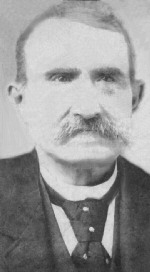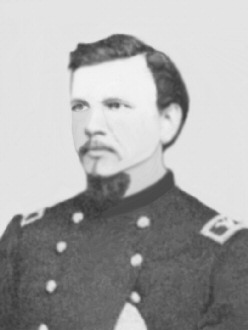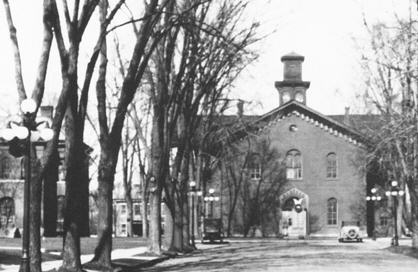An Event That Changed Macon Forever
By Merlyn Amadei - Information from Chronicle-Herald, 1910 General History of Macon County, The Civil War in Missouri, and Sally Watts
 Many people standing on Rollins Street today, look north at the courthouse, and really think nothing of it. The courthouse has always been there – and we hope always will be. However, it was not here until after the Civil War and it is here all because of a man named Thomas Moody. Many people standing on Rollins Street today, look north at the courthouse, and really think nothing of it. The courthouse has always been there – and we hope always will be. However, it was not here until after the Civil War and it is here all because of a man named Thomas Moody.
Moody was born in Kentucky in 1823 but came as a young man to the new state of Missouri and settled in this area in the spring of 1844. He married Eliza Wright in 1845 and they had nine children. Large families were the norm, but many young children did not live to adulthood. So it was with the Moody family, as only five of their children survived.
During the time of the Civil War Moody joined up wtih the Union forces although many of his friends supported the Confederacy. He served under General Lewis Merrill who was stationed here in Macon City. Moody's unit was made up mainly of local boys and most had been raised around here and near Bloomington – which at that time was the Macon County seat, so it was also where the County Courthouse resided, which lent it more importance that Macon.
 Because there were many Confederate sympathizers in the Bloomington area, General Merrill was upset. He had a deep hatred for anyone siding with the south and decided to make an example of ten confederate prisoners by executing them. He ordered Moody to assemble a firing squad. Because there were many Confederate sympathizers in the Bloomington area, General Merrill was upset. He had a deep hatred for anyone siding with the south and decided to make an example of ten confederate prisoners by executing them. He ordered Moody to assemble a firing squad.
Previously Moody had been able to use his influence on occasion to save southern sympathizers from harsh treatment, but not that time. He did not feel right shooting another Missourian who might be friend or family of someone he knew. But his request for a troop from another state to perform the executions was denied and he had to perform the dire deed.
Later, General Merrill instructed Major Moody to take his men to Bloomington and "burn the town to the ground, leave not one building standing. Wipe Bloomington off the face of the earth."
Moody could not bring himself to follow yet another harsh order such as this one. Instead, he came up with a viable plan and presented it to General Merrill the next morning.
"General," he said, "I want to speak to you about that Bloomington matter."
"Very good, have you razed the old town yet?" asked Merrill.
"No sir, I haven't, but I got a plan that will work a good deal better than to burn those people out!"
"Let's have it … What's your plan?"
"Bloomington is the county seat, it has the courthouse and all court records, but it's off the railroad and hard for people to reach," stated Moody. "Now suppose I run for legislature, and if I win, introduce a bill to move the courthouse here [to Macon] as an act of military necessity. That town [Bloomington] will then disappear off the map, same as if you had burned it."
The idea seemed to please the general so he agreed, and promised Moody that he would be elected. "If I find any man scratching you, I'll run him in the guard house!" he declared.
 So Moody was elected as a Democrat and a bill was brought before the 22nd General Assembly to move the county seat from Bloomington to Macon City. Since Bloomington was 'virtually outside the Union' and considered the seat of disloyalty in the county, it could not raise much of a protest. Earlier, its citizens had been disarmed by the military after 'aggravating activity by bushwackers'. The bill provided for the county seat to be removed from Bloomington, because it had to be within ¾ mile of the junction of the Hannibal-St. Joe and the Northern Missouri Railroads, and also changed the name of Macon City to Macon. So Moody was elected as a Democrat and a bill was brought before the 22nd General Assembly to move the county seat from Bloomington to Macon City. Since Bloomington was 'virtually outside the Union' and considered the seat of disloyalty in the county, it could not raise much of a protest. Earlier, its citizens had been disarmed by the military after 'aggravating activity by bushwackers'. The bill provided for the county seat to be removed from Bloomington, because it had to be within ¾ mile of the junction of the Hannibal-St. Joe and the Northern Missouri Railroads, and also changed the name of Macon City to Macon.
From here you can go to our Town History section and read more about the Macon County Courthouse.
And as Paul Harvey would say, "Now for the rest of the story ... "
As for Moody, after his term expired in 1866, he returned to Macon County. The war was over and he was elected president of the M & M Railroad Company, a position he held until 1868. He was one of the 'old settlers' and helped organize the first Old Settlers Reunion of Macon County which was first held July 4, 1879 at Bloomington.
He was a farmer and a member of the Bethel Christian Church. He had moved to Macon before his death and probably knew more about Macon County history than anyone else at the time. He died from complications of a stroke on August 4, 1910 and is buried at Mt. Tabor cemetery.
At the time of his death, his son N.M. Moody was the County Clerk of Macon County. Today, Major Moody still has descendants living in the area.
|